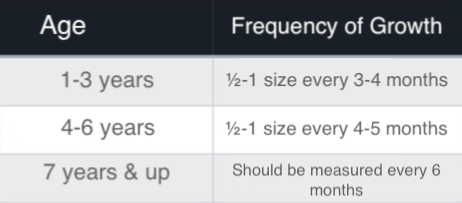How fast do toddler feet grow? On average, a toddler’s foot grows about half a shoe size every two to four months. However, the toddler foot growth rate can vary significantly between children and even fluctuate for the same child at different times. This guide will help you understand how quickly your toddler’s feet may be growing, what to look for when buying shoes, and how to track their foot size.

Image Source: www.littlefeetdenver.com
Fathoming Toddler Foot Growth
Rapid foot growth in toddlers is a common concern for parents. It seems like you just bought a new pair of shoes, and suddenly, they’re too tight! Let’s delve into the factors influencing toddler foot growth and what you can expect.
What Influences Toddler Foot Growth?
Several factors affect how quickly a toddler’s feet grow:
- Genetics: Just like height, foot size can be influenced by family history.
- Nutrition: A balanced diet supports healthy bone and tissue development.
- Activity Level: Active toddlers may experience more wear and tear, potentially influencing foot growth.
- Overall Growth Rate: Toddler foot growth rate often mirrors overall growth spurts.
The Science Behind Growing Feet
Bones grow through a process called ossification. In young children, the bones in their feet are primarily cartilage, which gradually hardens into bone. Because cartilage is flexible, a shoe that’s too tight can temporarily compress a toddler’s foot, making it difficult to accurately gauge their size.
Toddler Foot Growth Rate: An Overview
The toddler foot growth rate generally slows down after the first year. Here’s a rough timeline:
- 12-24 Months: Feet may grow approximately 1.5 mm per month.
- 2-3 Years: Growth slows down to about 1 mm per month.
- 3-5 Years: Growth becomes even more gradual.
These are average values, and individual experiences can vary considerably. It’s crucial to monitor your child’s feet regularly rather than relying solely on these estimations.
Estimating Toddler Foot Size: Growth Charts and Averages
While every child is unique, understanding average foot sizes for toddlers can give you a starting point. Keep in mind these are just averages, and accurate measurement is always best.
Average Foot Size Toddler: Charts and Data
The following tables provide average foot length measurements based on age. These are approximations, and individual foot sizes can vary. Always measure your child’s feet for the most accurate fit.
Table 1: Approximate Foot Length by Age (Inches)
| Age (Months) | Average Foot Length (Inches) |
|---|---|
| 12 | 4.5 – 5 |
| 18 | 5 – 5.5 |
| 24 | 5.5 – 6 |
| 30 | 6 – 6.5 |
| 36 | 6.5 – 7 |
Table 2: Approximate Foot Length by Age (Centimeters)
| Age (Months) | Average Foot Length (Centimeters) |
|---|---|
| 12 | 11.4 – 12.7 |
| 18 | 12.7 – 14 |
| 24 | 14 – 15.2 |
| 30 | 15.2 – 16.5 |
| 36 | 16.5 – 17.8 |
Converting Inches/Centimeters to Shoe Sizes
Shoe sizes vary by brand and region (US, UK, EU). After measuring your child’s foot, consult a shoe size conversion chart specific to the brand you are considering. Many shoe stores have these charts available.
Toddler Shoe Size Progression: What to Expect
Toddler shoe size progression is not always linear. It often involves small increments as they grow. You might see a toddler shoe size progression like this:
- Size 4
- Size 4.5
- Size 5
- Size 5.5
- Size 6
It’s essential not to jump sizes unless the measurements clearly indicate the need.
Recognizing Rapid Foot Growth in Toddlers
Toddler feet growing fast can be hard to keep up with, but knowing the signs can help you stay ahead.
Signs Toddler Needs New Shoes
Here are some signs that your toddler needs new shoes:
- Toe Cramping: Toes are visibly bent or scrunched inside the shoe.
- Red Marks: Red marks or blisters on the feet after wearing shoes.
- Resistance: Toddler resists wearing shoes, potentially due to discomfort.
- Visible Bulge: A bulge appears on the shoe where the big toe is pressing.
- Frequent Stumbles: Sudden increase in stumbling, suggesting shoes don’t fit correctly.
Foot Growth Spurts Toddler: What to Expect
Just like overall growth spurts, there can be toddler foot growth spurts. During these times, you may notice a more rapid increase in foot size. Be extra vigilant during these periods and measure your child’s feet more frequently.
When to Measure Toddler Feet: Best Practices
Knowing how often measure toddler feet toddler and the best techniques is crucial for proper shoe fitting.
How Often Measure Toddler Feet Toddler: A Recommended Schedule
- Every 1-2 Months (1-3 Years): Due to rapid growth, check foot size every 1-2 months.
- Every 2-3 Months (3-5 Years): As growth slows, checking every 2-3 months is sufficient.
Step-by-Step Guide to Measuring Toddler Feet
- Gather Supplies: You’ll need a ruler or measuring tape, a piece of paper, and a pen.
- Prepare the Area: Place the paper flat against a wall on a hard surface.
- Position Your Child: Have your child stand with their heel against the wall, placing their foot firmly on the paper. Make sure they are standing with their full weight on the foot being measured.
- Trace the Foot: Carefully trace around your child’s foot. For best accuracy, wear the socks that they would wear with the shoes.
- Measure the Length: Measure the distance from the heel to the tip of the longest toe.
- Measure Both Feet: Repeat the process for the other foot, as foot sizes can vary slightly. Use the larger measurement when selecting shoe sizes.
- Account for Socks: When measuring, have your child wear the type of socks they will usually wear with the shoes.
When is the Best Time to Measure?
Measure your child’s feet in the afternoon or evening. Feet tend to swell slightly throughout the day, so measuring later ensures you get the most accurate size.
Picking the Right Shoes for Growing Feet
Choosing the right shoes is crucial for supporting healthy foot development.
Features of Good Toddler Shoes
- Flexibility: The shoe should bend easily at the ball of the foot.
- Breathability: Materials like leather or mesh help feet stay dry and comfortable.
- Wide Toe Box: Allows toes to wiggle freely and prevents cramping.
- Secure Fit: Shoes should stay on without being too tight. Velcro straps or laces work well.
- Lightweight: Heavy shoes can hinder natural movement.
- Flat, Flexible Sole: Offers the best support for learning to walk.
What to Avoid
- Shoes That are Too Stiff: Restrict natural foot movement.
- Pointed Toe Boxes: Cramp toes and can lead to foot problems.
- Heavy Shoes: Can cause fatigue and affect gait.
- Shoes Without Breathability: Can lead to sweaty feet and potential skin issues.
- Hand-me-down Shoes: Shoes mold to the previous wearer’s foot, which can affect your toddler’s foot development.
The Importance of Professional Shoe Fitting
If possible, visit a shoe store with trained staff who can measure your child’s feet and recommend appropriate shoes. A professional fitting can provide valuable insights into your child’s specific needs.
Foot Health for Toddlers
Proper foot care is essential for preventing problems and ensuring healthy development.
Common Foot Problems in Toddlers
- Ingrown Toenails: Trim toenails straight across to avoid this.
- Athlete’s Foot: Keep feet clean and dry to prevent fungal infections.
- Plantar Warts: See a pediatrician for treatment.
Tips for Healthy Feet
- Regular Washing: Wash feet daily with soap and water.
- Proper Nail Trimming: Trim toenails straight across to prevent ingrown nails.
- Breathable Socks: Choose cotton or wool socks to wick away moisture.
- Avoid Walking Barefoot in Public Places: Protect feet from germs and injuries.
- Check Feet Regularly: Look for any signs of redness, blisters, or other issues.
FAQs About Toddler Foot Growth
- What is the average foot size for a 2-year-old?
The average foot size for a 2-year-old is approximately 5.5 to 6 inches (14 to 15.2 cm). However, it’s essential to measure your child’s feet for the most accurate fit. - Can I rely on shoe sizes alone when buying shoes for my toddler?
No, shoe sizes can vary between brands and styles. Always measure your child’s feet and consult a shoe size chart specific to the brand you are considering. - What are the long-term effects of wearing shoes that are too small?
Wearing shoes that are too small can lead to foot problems such as bunions, hammertoes, and ingrown toenails. It can also affect your child’s gait and posture. - Who is the best person to consult if I have concerns about my toddler’s foot development?
Consult your pediatrician or a podiatrist if you have concerns about your toddler’s foot development. They can assess the situation and provide appropriate recommendations. - Why do toddler feet grow so fast?
Toddler feet grow quickly because bones grow rapidly in early childhood. Their bones are mostly cartilage, which allows for significant growth within a short period.
By staying informed about your toddler’s foot growth and following these guidelines, you can ensure they have comfortable, well-fitting shoes that support healthy foot development. Remember to measure frequently, choose appropriate footwear, and consult professionals when needed.

Clark Lubowitz is a parenting expert with over 10 years of experience in toddler care and child development. Holding a degree in Early Childhood Education, he specializes in blending modern technology with parenting, offering expert advice on the best toddler gadgets. Through his work on ToddlerAwesome.com, Clark provides valuable insights to help parents make informed decisions for their little ones.
